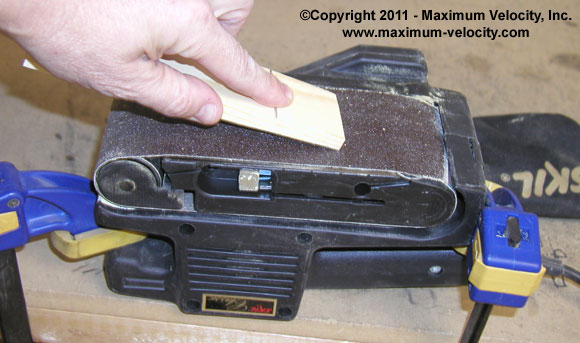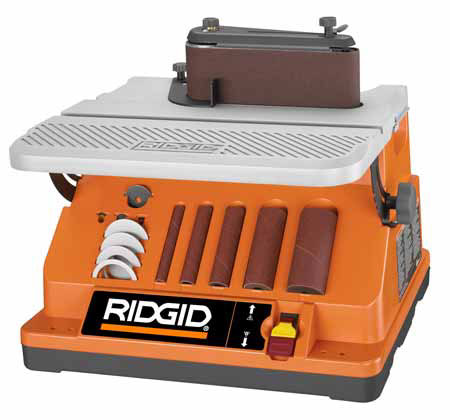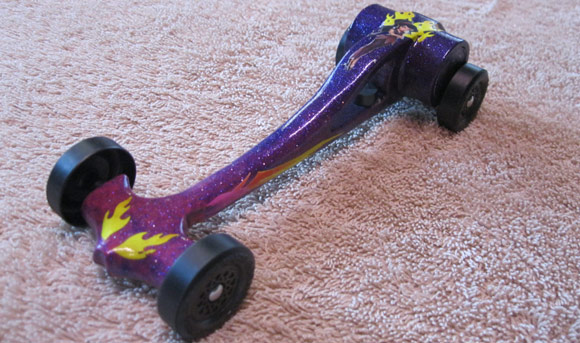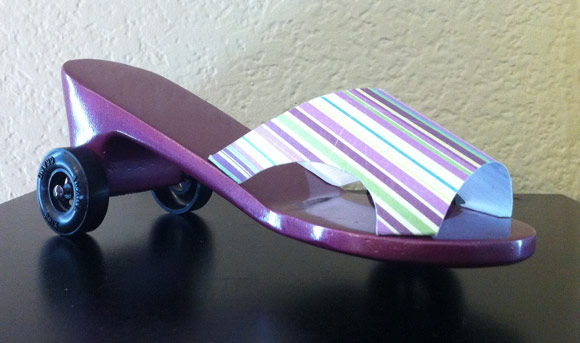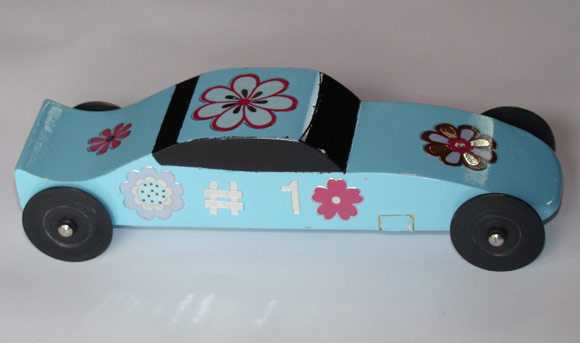– Feature Article – Shop Talk: Bench Top Power Sanders
– Pinewood Derby Car Showcase
– Q&A
Shop Talk: Bench Top Power Sanders for Pinewood Derby Car Building
By Randy Davis
If you build more than one pinewood derby car per year, then you will already know that shaping a car without some type of power sander is a real chore. Just eliminating the teeth marks left by the saw is a chore, much less trying to create nice curves and contours.
I have used many different power sanders, so in this Shop Talk I’ll share the ins and outs of the various products that are available (and affordable) for the home shop.
A Word of Caution
With any power tool, precautions must be taken to avoid personal injury. Always wear eye protection, tie up long hair, remove hanging jewelry and tuck in shirts. Always read and follow the manufacturer’s safety warnings. Finally, power sanders produce a lot of dust. So, where possible use dust collection equipment, and always were a dust mask.
Belt Sander
The first power sander I used was a belt sander, turned upside down and clamped to a work bench. Let me tell you, this was a big step forward from hand sanding, as you can really take off a lot of wood, and can readily make contours.
Figure 1 – Belt Sander
But please note that I do not endorse this method of using a belt sander, as it is not intended to be used this way. This method of sanding introduces several problems. First, the sander wants to take the car body right out of your hand and throw it against the wall (or automobile, or whatever is in the way). You really have to hang on to the car body. The second issue is that if you do not apply even pressure on the block, you can easily end up with a lopsided block. Finally, especially with thin cars, the tips of your fingers are fair game for abrasion, so a lot of care must be taken.
Home Depot List Price: $50 and up
Belt/Disc Sander
A big step up from a belt sander is a Belt/Disc Sander. These come in several varieties, one of which is the Ryobi model shown in Figure 2.
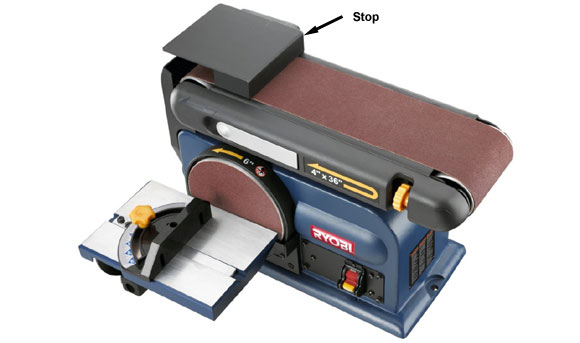
(Source: Ryobi website)
The Belt/Disc Sander is a bench top tool (meaning it is screwed down to a work bench), so clamps are not required. The belt sander part is equipped with a stop, so that the car body is not easily taken out of your hand. The disc sander part is nice for sanding the back end of the car and for making round corners. Since the disc is square to the supporting table, you can ensure that a right angle is formed when using it.
Of course, like the belt sander, the belt/disc sander can still remove finger tips, and when using the belt, poor technique will result in uneven cars.
Home Depot List Price: $119
Narrow Belt Sander
A specialty power sander that can be used is the narrow belt sander. It is much less common as it is not as useful as the belt/disc sander (however, there is a combination narrow belt/disc sander available).
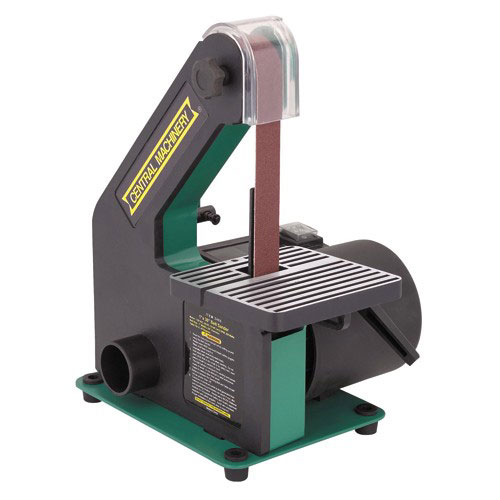
(Source: Harbor Freight web site)
The narrow belt allows you to sand straight edges that are inset into the car body, such as on our Arrow design (Figure 4). However the edge of the belt can cut into the wood, so you need to continually move the car body back and forth across the belt, and apply minimal pressure.
Harbor Freight List Price: $50
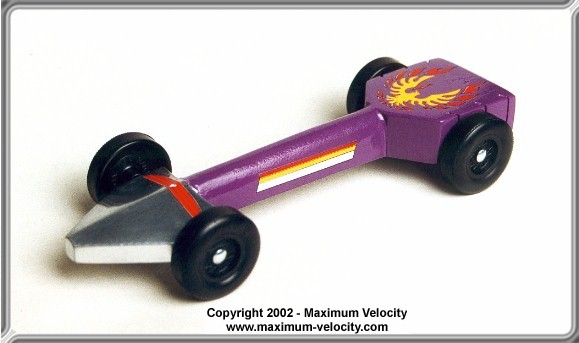
Spindle Sander
Another type of sander that is handy for building pinewood derby cars is the spindle sander. The spindle sander has sanding drums of various diameters that are used to create concave curves. For example, a spindle sander would be used to create the side on our Detonator design (Figure 6).
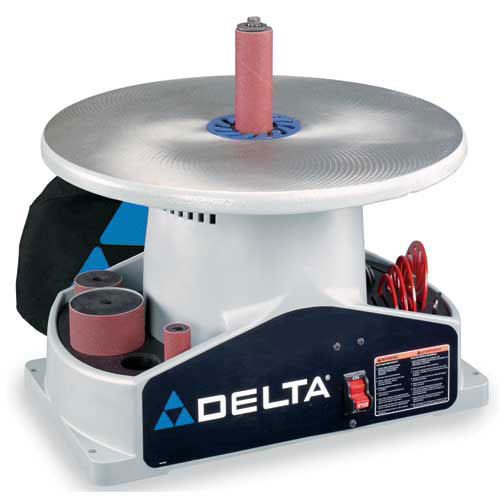
(Source: Delta Tools web site)
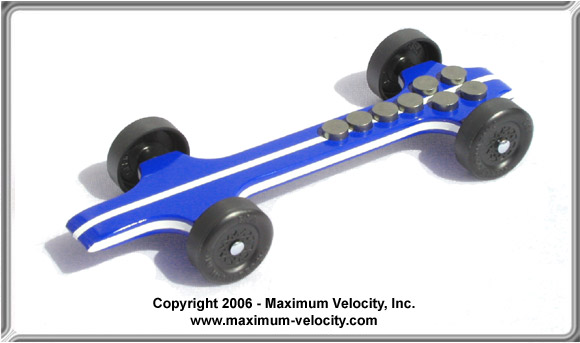
Spindle sanders oscillate, that is, the sanding drum moves up and down to maximize the use of the drum and to increase the sanding action. They also have some type of dust collection, so less dust piles up on the support surface and hovers in the air.
Spindle sanders are special purpose (like the narrow belt sander), so unless you make cars with convex curves, it will tend to just collect dust. But when you have a need for it, the spindle sander is a godsend.
Sears List Price – $300 (A less expensive model is available at Harbor Freight)
Oscillating Edge/Belt Sander
I have a confession to make; I don’t use any of the products listed above anymore. Several years ago I ran across the Ridgid Oscillating Edge/Belt Sander (Figure 7), and it is the only sander I now use.
Figure 7 – Ridgid Oscillating Edge/Belt Sander
(Source: Ridgid website)
The Ridgid sander is a home shop version of a floor mounted oscillating belt sander used at most cabinet shops. Back in high school, I worked at a cabinet shop, and used a commercial oscillating belt sander every day. So when I found the Ridgid sander, I knew it was a must for the shop.
The sanding belt (which is a standard size used on regular belt sanders) oscillates up and down, maximizing the use of the belt and increasing the sanding action. It is square to the work surface, so you can ensure that the sides of your car are square to each other. A stop is included to keep the car body from flying away. The stop can be easily removed so that the large diameter drum (left side in the photo) can be used for rounding inner curves.
But that is not all. If the drum is too large, the Ridgid sander easily converts to a spindle sander (Figure 8). It comes with five different drums, and the parts to make the drums fit properly.
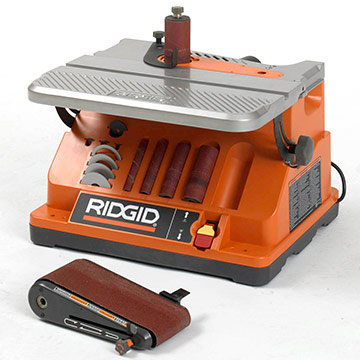
(Source: Ridgid website)
As with any belt sander, care must be taken to avoid abrading a finger. Also, dust collection is a necessity. This sander produces lots of dust, and if the dust is allowed to collect in the area under the oscillating belt, it will eventually clog up the machine. The sander is equipped with a dust collection port in the back, which can be attached to a shop vacuum or to dust collection equipment. Make sure to do so.
Home Depot List Price – $200
Conclusion
Although all of these sanders have their purpose, I believe the Ridgid sander is the best choice for most pinewood derby projects. It combines the best features of a belt/disc sander with the benefits of a spindle sander.
Pinewood Derby Car Showcase
Purple Pixie – Gary Olesky
Little 4 year old Ali and adopted grandpa for the day, Gary Olesky, took on her brother Sebastian and all the other boys at a Cubscout pinewood derby Race. The boys were not happy losing to the purple and pink pixie car, which turned in the fastest time of the day.
The Shoe – Jeremy Isaac
My daughter ran the shoe, which took first in both Speed and Novelty in the Awana Cubbies division. The speed competition wasn’t very stiff this year – the car was reasonably fast, but shouldn’t have won in my opinion.
Blue Flower – James White
My granddaughter (Olivia) and I built this car for her to race against her brother. Olivia calls her car “Blue Flower”.
Q&A
Does the height of the center guide rail on a track measure 0.375, or is it thinner.
In most races, the required clearance for the car is 3/8 inch, while the guide rail height is less (usually between 1/4 and 5/16 inch). The extra clearance makes sure the cars clear the rail through the curved transition.
In your speed tip book, “Speed to the Finish”, in the discussion on the rail rider technique, you say to gap the back wheels twice as wide as the front wheels. What gap do you mean? If the front is 1/32 inch, is the back 1/16 inch?
I recommend a wheel to car body gap of .030 inch, which is essentially the thickness of a standard credit card. We offer a Gap Gauge of this thickness.
So, for rail-riding, the front wheels would be set at .030 inch, and the back wheels would be set at .060 inch.
Is it best to bend the axles so less of the wheel is touching the track, and if so, which axles are bent, and how much?
In my tests on an aluminum track, there was no advantage to cambering the rears wheels unless you implement rail-riding alignment. However, on a wood track there may be some advantage to just cambering the rear wheels.
For rail-riding use smooth axles (non-grooved) and angle the rear axles at 2.5 degrees upwards. The front dominant wheel is angled at 1.5 degrees downwards for steering the car. If you must run four wheels on the ground, then camber both front wheels at 1.5 degrees and adjust them to work together to steer the car. Typically a drift of 5 inches over 8 feet will provide ensure proper rail-riding.
Want Answers?
Do you have a pinewood derby-related question? If so, e-mail us your question.We answer all questions by e-mail, but not every question will appear in the Q&A section of the newsletter.
Back Issues
Are you a new subscriber, or have you missed some of the previous newsletters? Don’t miss out; all of the issues for Volume 5 through Volume 17 are posted on our web site.
Newsletter Contributions
We welcome your contributions. If you would like to contribute an article, a web site review, a speed tip, or a pinewood derby memory, please e-mail us.
Subscription Information
The Pinewood Derby Times is a free e-newsletter focused on pinewood derby racing. It is published biweekly from October through March.
If you haven’t already done so, please forward this issue to your pinewood derby friends. But please don’t subscribe your friends. Let them decide for themselves. Thanks.
If this newsletter was forwarded to you, why not subscribe to receive this newsletter. There is no cost, and your e-mail address is safe, as we never sell or share our distribution list.
To subscribe, send a blank e-mail to
[email protected]
You will receive a confirmation e-mail. Reply to the confirmation e-mail and you will start receiving the Pinewood Derby Times with the next issue.
Randy Davis, Editor, Pinewood Derby Times
E-Mail: [email protected]
(C)2018, Maximum Velocity, Inc. All rights reserved. Please do not reprint or place this newsletter on your web site without explicit permission. However, if you like this newsletter we grant permission, and encourage you to e-mail it to a friend.
Maximum Velocity disclaims any personal loss or liability caused by utilization of any information presented in this newsletter.
The Pinewood Derby Times is not specific to, and is not affiliated with the Boy Scouts of America, YMCA, Awana, or any other organization.
(R)Maximum Velocity is a registered trademark of Maximum Velocity, Inc.
(R)Pinewood Derby is a registered trademarks of the Boys Scouts of America.
(R)Awana is a registered trademark of Awana Clubs International.
All other names are trademarks of their respective owners.

